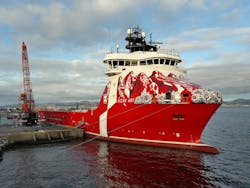SBM secures financing for second Liza FPSO
SBM Offshore has completed the project financing of the FPSO Liza Unity for a total of $1.14 billion.
The project financing was secured by a consortium of nine international banks. The company expects to draw the loan in full, phased over the construction period of the FPSO. The financing will become non-recourse once the vessel is completed and the pre-completion guarantees have been released.
The project loan has a tenor of two years post completion, in line with the duration of the charter, and carries a variable interest cost of LIBOR plus 1.50%.
The FPSO Liza Unity design is based on SBM’s Fast4Ward program, which incorporates a newbuild, multi-purpose hull combined with standardized topsides modules.
The FPSO is designed to produce 220,000 b/d of oil, with associated gas treatment capacity of 400 MMcf/d, water injection capacity of 250,000 b/d and storage capacity of 2 MMbbl.
The Liza Unity is part of the ExxonMobil-operated Liza Phase 2 development offshore Guyana. Located about 124 mi (200 km) offshore in the Stabroek block, the FPSO will be spread moored in a water depth of about 5,249 ft (1,600 m).
Keppel delivers fourth jackup to Borr
Keppel Offshore & Marine Ltd. subsidiary Keppel FELS has delivered the Hermod, a KFELS B Class design jackup, to Borr Drilling. This is the fourth of 11 jackup rigs the yard is currently constructing for the drilling contractor.
Svend Anton Maier, CEO of Borr Drilling, said: “The global jackup drilling rig fleet utilization has been on an upward trend, driven by increasing utilization of modern rigs such as Keppel’s B Class rigs.
“Demand also continues to grow, with various jackup rig tenders across the world.”
KFELS B Class rigs are designed to operate in 400 ft (122 m) water depth and drill to 30,000 ft (9,144 m).
The Hermod is the 70th KFELS B Class rig to enter the market, according to Tan Leong Peng, Executive Director (Newbuilds) of Keppel O&M.
The company previously delivered the jackups Saga, Skald, and Thor to Borr.
Wärtsilä battery hybrid systems in demand
Atlantic Offshore and Eidesvik AS have both contracted Wärtsilä to deliver hybrid propulsion systems.
The Fitjar shipyard in Norway will equip the Atlantic Offshore supply vessels Ocean Star and Ocean Art with the 746 kWh battery hybrid systems.
Wärtsilä designed both ships, each of which has the company’s engines and its Low Loss Concept electrical systems. The latter are said to reduce electrical losses and provide higher individual engine loads, resulting in improved fuel efficiency.
The company expects to complete the project early next year.
For the Eidesvik offshore construction vessel Viking Neptun, the company will supply two 870-kWh battery packs and two 2.7-MW drives for the hybrid system, pre-installed in containers.
With the battery hybrid solution, the 15,900-dwt vessel is expected to be able to operate on a single generator set supplemented by batteries during dynamic positioning operations.
Wärtsilä claimed its solution should deliver further benefits in the form of fuel cost savings, better environmental performance, and lower maintenance costs as the load on the engines should be more efficient and the running hours reduced.
It will also upgrade the existing switchboard, integrated automation and power management systems. The program is expected to take up to six months to complete.
Transocean Spitsbergen features hybrid power system
Transocean Ltd. has deployed what it claims is the world’s first hybrid energy storage system aboard a floating drilling unit. The system is now operational on the semisubmersible Transocean Spitsbergen, which is drilling at the Equinor-operated Snorre field offshore Norway.
Transocean’s patented hybrid power technology, developed in partnership with Aspin Kemp and Associates, is said to reduce fuel consumption and increase a dynamically positioned rig’s station-keeping reliability by capturing energy generated during normal rig operations that would otherwise be wasted, and storing it in batteries. This energy is then used to power the rig’s thrusters. This operational and safety enhancement targets a 14% reduction in fuel use during normal operations, leading to a reduction in NOx and CO₂ emissions.
The company’s investment is funded in part through fuel saving incentives in its contract with Equinor and by the Norwegian NOx Fund. •
About the Author
Jessica Stump
Editor
Jessica Stump is editor of Offshore Magazine. She uploads and writes news to the website, assembles surveys and electronic newsletters, and writes and edits articles for the magazine. She was the summer editorial intern at Offshore in 2009 and 2010 before joining full time in April 2011. She has a journalism degree from Texas Tech University.



